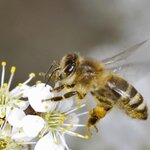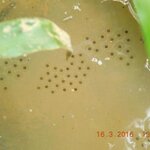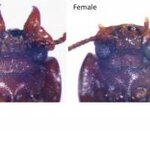Ecology & Zoology

Horseshoe crabs are classic living fossils. These marine and brackish water arthropods of the order Xiphosura are slowly evolving, conservative taxa.
Much like (slow) Water Striders (Aquarius remigis), (lackadaisical) Coelacanth (Latimeria chalumnae) and (the current winner on torpid evolution) Elephant Sharks (Callorhinchus milii), these fellows have a long history in the fossil record with very few anatomical changes. But their leisurely change provides loads of great information. It makes our new friend, Yunnanolimulus luoingensis, shown here an especially interesting and…

The number one killer of honeybees is not pesticides, despite expensive marketing campaigns by environmental groups trying to claim that is the case (1), and it isn't even the very lucrative industry of trucking bees around to engage in artificial pollination for crops like almonds, which leads to shock from being in new places. It's nature, bee losses overwhelmingly occur due to winter but secondarily happens in the form of pests and diseases.
As beekeeping revenue has become more about induced pollination rather than honey, there has been concern that such "intensification" will lead…

If you're lucky enough to swim in the warm, shallow waters of the Indo-Pacific region, you may encounter one of the most charming of all the sea stars, the Protoeaster nodosus. These beauties are commonly known as Horned Sea Stars or, my personal favorite, Chocolate Chip Sea Stars.
They are part of the class Asteroidea (starfish or sea stars) one of the most diverse groups within the phylum Echinodermata and have a lengthy lineage in the fossil record stretching all the way back to the Triassic. These echinoderms make a living on near-shore sandy bottoms or lurk in the sea grass meadows…

Meet one of the most adorable of all the Living Fossil species, the Elephant shrew, Macroscelides proboscideus, one of 15 species of this order. These small, quadrupedal, insectivorous mammals strongly resemble rodents or opossums with their scaly tails, elongated snouts, and rather longish legs.
They are widely distributed across southern Africa in a variety of habitats, desert, forest, dry rocky outcrops, from the Namib Desert down to South Africa. And they are speedy little things, clocking in at up to 28.8 km / 17.9 mph, making them one of the fastest of our small mammals. These…

In April 2017, journalists promoted a claim about plastic bag eating caterpillars which led to sensationalistic coverage in worldwide media. They could eat the sea-sized floating islands of plastic bags that don't actually exist.
The science community was skeptical.
The authors reported that the larvae of the wax moth Galleria mellonella were able to digest polyethylene (PE), a polymer used for making plastic packaging and bags. Though media can promote any study they want quickly, a re-examination of claims takes time, and gets far less attention. Till Opatz, professor for Organic…

It's quite common for the circle of life to have animals eating plants in order to become bigger food for other animals and then animals die and become food for organisms in the soil but nature has flipped the script again.
In what is believed to be a first for North America, biologists at the University of Guelph have discovered that meat-eating pitcher plants in Ontario's Algonquin Park wetlands consume not just bugs but also young salamanders. They are cleverly calling it "the little bog of horrors", a play on the movie "Little Shop of Horrors" from the 1960s which then became, of…

Researchers doing observations in Myanmar's Htamanthi Wildlife Sanctuary found that rain-filled tracks of Asian elephants (Elephas maximus) were filled with frog egg masses and tadpoles. The tracks can persist for a year or more and provide temporary habitat during the dry season. Trackways could also function as "stepping stones" that connect frog populations.
Though ecologists regard humans modifying the landscape as a bad thing, when elephants trample the environment they are termed "ecosystem engineers" credited with seed dispersal and converting large amounts of plants into…

In only 10 percent of flowering plant species do female and male flowers exist on separate plants, where they typically remain female or male throughout their lifetime. The other 90 percent combine both sexes in one plant.
Striped maple trees (Acer pensylvanicum) are part of the 10 percent, but a new study found something even more interesting - rather than remaining fixed during their lifetime, 54 percent changed sexes over a four-year period, with some switching at least twice. But not without cost. Though only female trees can make seeds, male trees usually outnumber female trees by…

The "loser effect"- avoiding violence after losing a fight - evolves independently of any change in fighting ability, according to results after scientists studied male broad-horned flour beetles, which regularly fight over females, to see how long they avoided fights after a defeat.
Most would not start a fight for about four days after a loss, but researchers selectively bred the beetles for a shorter duration of this loser effect and found that it evolved to be shorter - despite no improvement in fighting prowess.
"Theory predicts that the loser effect should evolve…

Yes we are getting extinctions at a far higher rate than normal. But it is nowhere near a mass extinction yet. Just the start of a slide towards one that may play out towards the end of this century and in the 22nd century. Also we are not risking a major mass extinction like the Permian / Triassic one. The word “mass extinction” does not have a well defined threshold but I think many who read these stories think it means that there would be almost no animals, fish, trees, plants or insects left or hardly any. No it doesn’t mean that. It means fewer species of each but not a world without…